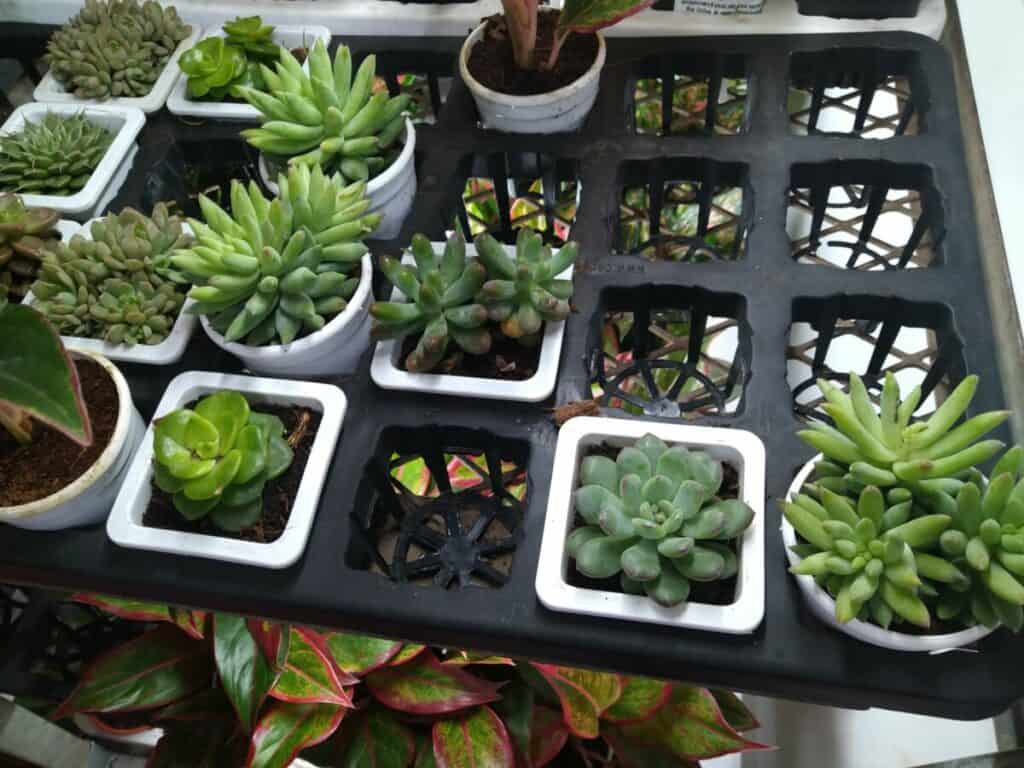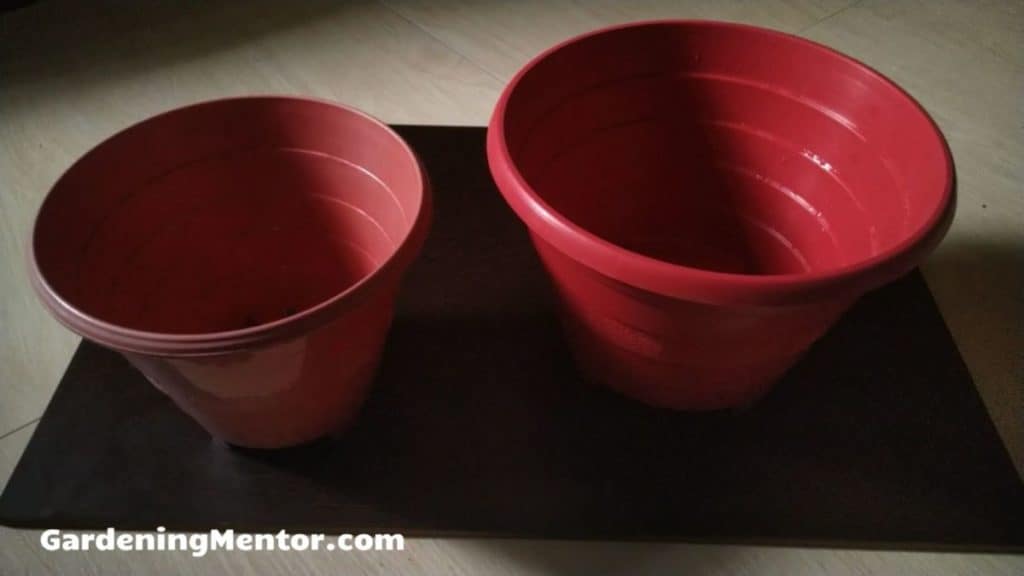Like many gardeners, I often start my plants in pots before moving them to a garden bed. Usually, this involves a careful transplant process. I wanted to see if I could save skip some steps and bury plants in the pots they grow in. To find out, I researched this topic and found some interesting information.
You can bury plants in pots to limit their growth. This is beneficial for invasive varieties of plants such as mint. This helps prevent the invasive plants from preventing other plants to grow near them. You will need to maintain the right moisture and nutrients for plants in pots.
I’ve written a lot more details of how burying plants in pots can benefit your garden and the entire process of how you can do this.
Is It OK To Bury Plants in Pots?
It’s a fairly common practice that’s beneficial to invasive plants and those that can propagate by division. Buying plants in pots provides you with greater control over how your plants grow. You can give plants a bit more freedom while still keeping the root structure contained.
Many plants can thrive in this growing environment. But, there’s an art to doing it correctly.
If you’re not careful, you could run into a couple of problems.
Potential Issue
The two biggest obstacles you could face when burying pots poor growth and degradation of the container.
Some plants need ample room to spread their roots. Attempting to grow those plants in a container long-term can impact its development. The roots will continue growing until they hit the sides of the container. Then, they have nowhere to go. As a result, they get pot bound.
When this happens, the growth cycle pretty much stops in its tracks.
If you want to bury plants in pots, you have to ensure that the pot is big enough to support continued growth. This gardening method is usually best for shallow or medium-depth root systems.
Another issue you may encounter is the breakdown of the container.
Plastic pots are lightweight and flexible. Most manufacturers use an inert material that’s completely safe for your plants.
But what if you leave the pot in the ground for months or years?
Eventually, they can become brittle. This leads to cracking and chips. Lower-quality plastic pots may even leach chemicals into the soil, which is something you don’t want.
To avoid plastic-related problems, you must choose high-quality pots that last. Look for thick plastic materials. Or better yet, choose terracotta pots or biodegradable containers.
What are the Benefits of Burying Plants in Pots?
For the most part, burying plants in pots is a safe practice. It offers a few distinct benefits that can address some common gardening problems.
1. Controlling Invasive Plants
Invasive plant species are notorious for taking over gardens. There are a number of ways that these plants get around. Some will release seeds that fly with the wind. Others rely on pests to multiply. Planting your pots won’t address all of those spreading methods.
But, the pots can stop the underground spread. Some invasive plants use rhizomes to take over. The rhizomes spread horizontally and sprout shoots from new nodes. Before you know it, you’ll have multiple plants.
With a physical barrier like a pot, the rhizomes have very limited space to work their ugly magic.
2. Stopping Propagation
You can look at plant propagation as another invasive survival tactic. In addition to rhizomes, plants can produce vertical plant suckers or tubers. Many plants can also multiply using horizontal stolons.
Ornamental grasses, some perennials, and succulents are the worst offenders.
Propagation usually occurs under the soil. So, having a pot as a barrier can reduce division significantly.

3. Reducing Allelopathic Killings
Plant allelopathy is an interesting phenomenon. It’s a biological function that causes nearby plants to affect one another. Think of it as plant communication.
In some cases, this interaction is beneficial. But in a vast majority of instances, it results in the death of one plant.
Allelopathic plants will release chemicals from the root system. The chemicals change the soil to stunt or kill nearby plants.
When you bury the plant with its pots, those chemicals are unable to spread to other plants.
4. More Versatility
If you’re someone who likes to change things up in your garden from season to season, burying pots is the way to go.
Called the pot-in-a-pot method, this technique involves planting two pots in the soil. The inner pot is the one that contains the plant. When you want to replace the plant, just remove the inner pot. It’s quick, easy, and doesn’t require any digging.
How to Bury Plants in Pots in the Ground
Burying plant pots is not difficult at all. The first step is choosing the right container.
Selecting a Pot
Chances are, the pot your plant is already growing in will work just fine. But, you may want to do a quick transplant to get better results.
As I mentioned earlier, you need a high-quality pot if you use plastic. Make sure it has adequate drainage. You can cut off the bottom to improve drainage if the existing pot doesn’t have large holes.
Terracotta pots work well, too. They are porous by nature. As a result, the material holds onto water and keeps the soil inside moist. Like plastic, you need to make sure it has good drainage.
Biodegradable pots made of peat, coconut coir, or paper are best if you want to improve the soil. But, they only last about three years before they start breaking down.
Digging Your Holes
Once you have your pot situation worked out, it’s time to start digging.
Dig a hole that’s about two inches deeper and two inches wider than the pot. You can use a standard shovel. Though, post-diggers are better for creating vertical sides.
Now, place your pot in the hole and use dirt to make it level.
Filling the Holes
Here’s where you need to make a decision. You can fill in the extra space around the hole with dirt or bark mulch. The dirt will create a lot of pressure around the sides of the pot for a more secure fit.
Bark or chip mulch is a bit looser. As a result, the pot will be easier to remove int he future. Plus, it can increase drainage and create another safety barrier against strong roots.
Either option is fine. It’s all a matter of personal preference and meeting the needs of your plants.
Using the Pot-in-Pot Method
If you want a garden arrangement with more flexibility, you can bury two pots together. Great for annual plants, creating this setup is a cinch.
Use two similarly sized pots. They should fit into one another perfectly. It’s a good idea to create some additional drainage holes in the bottom pot to be on the safe side.
Like the standard pot burial method, dig a hole that’s two inches deeper and wider. Place the empty pot inside the hole and fill in the extra space with dirt. You want this first pot to be extra snug. The lip of the pot should be flush with the surface of the soil.
Now, just place the potted plant in the first pot. It’s as easy as that.
How to Take Care of Plants in Pots in the Ground
There are no major differences in caring for buried plant pots. Your plants should continue to grow and flourish as if they were in the ground.
If you have moisture-loving plants, you may want to water a bit deeper. Deep watering will ensure that the roots are getting all the hydration they need. Only do this if you suspect that your plants aren’t receiving enough water.
Another thing you might want to consider doing is applying mulch.
Not only will it help keep the soil moist, but it will clean up the look of your garden a bit. You can use it to hide the edges of the pot for a more natural appearance.
The mulch can also smother any weeds that try to pop up. Apply one to two inches of mulch around the plants. Make sure to leave some space around the stems of the plant to avoid disease and fungal issues.
Fact Checked, Written, and Published by Kevin Rodrigues
Kevin is the founder of Gardening Mentor, a website that aims to teach people to grow their own food in a limited space. As a self-taught gardener, Kevin has spent several years growing plants and creating gardening content on the website. He is certified in Home Horticulture and Organic Gardening from Oregon State University. He has a Post Graduate Diploma in Horticulture and Landscape Gardening from Mumbai University.
Read more


